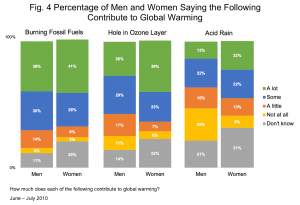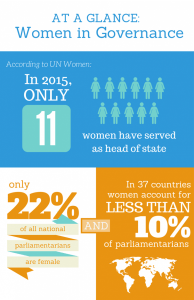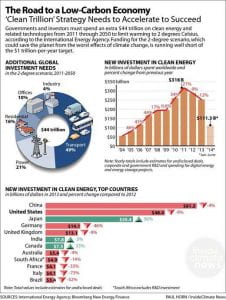 Norgaard and York’s discourse is about interconnection to the exploitation of women and nature, as it relates to politics. Part of the “empirical” evaluation (male/female researchers) focused in on inequality having to do with gender and the impact it have on how women in some states are able to gain positions in parliament which allows them to push for environmental safety. Heavy emphasis on this selection displayed how the roles of women being caretakers of the home, family and the community, plays a part in representation when it came to state environmentalism. Their analysis not only covered how the “gender gap” pertaining to the environment differed from state to state and highlighted “the numerical impact” which largely depends on economic data. But it also showed that “if women tend to be more environmentally progressive, the inclusion of women as well as members of society – as voters, citizens, policy makers and social movement participants – should positively influence behavior” (Norgaard, York; 508). The thought process was that women would have a voice, particularly in national legislative council which could empower a more constructivist balance for gender and the environment. However, (and as stated above) Norgaard and York argued that this view could be an optimistic one, simply because women are indeed seen as “nurturers and caretakers”, less being part of a political body.
Norgaard and York’s discourse is about interconnection to the exploitation of women and nature, as it relates to politics. Part of the “empirical” evaluation (male/female researchers) focused in on inequality having to do with gender and the impact it have on how women in some states are able to gain positions in parliament which allows them to push for environmental safety. Heavy emphasis on this selection displayed how the roles of women being caretakers of the home, family and the community, plays a part in representation when it came to state environmentalism. Their analysis not only covered how the “gender gap” pertaining to the environment differed from state to state and highlighted “the numerical impact” which largely depends on economic data. But it also showed that “if women tend to be more environmentally progressive, the inclusion of women as well as members of society – as voters, citizens, policy makers and social movement participants – should positively influence behavior” (Norgaard, York; 508). The thought process was that women would have a voice, particularly in national legislative council which could empower a more constructivist balance for gender and the environment. However, (and as stated above) Norgaard and York argued that this view could be an optimistic one, simply because women are indeed seen as “nurturers and caretakers”, less being part of a political body.
Following part of their study, Norgaard and York’s outlook of feminist theory saw links of oppression centered on socio-economic factors (gender, race, class). A revelation of “ecofeminists links between gender and environmental behavior of nations-states goes beyond gender equality to social equality more generally” (Norgaard, York 518). The data showed a prevalence in gender inequality and environmental degradation, particularly in poor states such as Singapore, as “wealth and modernization” was above environmental protection. Whereas, states such as Norway, in spite gender differences, women were able to bring their initiative for environmental protection to policy and law. They stated that for this reason, “Norway continues to take the lead on this convention and many other environmental issues and currently has one of the highest rates of participation of women in government in the world…Singapore provides a contrast with Norway in several respects, particularly on levels of gender equality and environmental treaty ratification. Therefore, Singapore’s environmental record is generally poor, even beyond the failure of treaty ratification” (Norgaard, York; 517). They concluded their report by discussing how “global efforts aimed at developing environmental policies should therefore concentrate more on improving the status of women, including especially those efforts aimed at increasing women’s political representation” (Norgaard, York; 519).
The “Paris Agreement” is an example of how women can make a global difference in climate change/ environmental degradation. The agreement is one that was made to prevent global temperatures from rising causing damage due to carbon and other greenhouse gases. Women’s participation was critical to the agreement for many reasons including “1) Women, especially poor women in developing countries, are often the most vulnerable to climate impacts as a result of social structures and existing inequalities, 2) Women are more likely than men to engage in environmentally sensitive behaviors, such as recycling, conserving water and using environmentally friendly products, and 3) UNDP’s 2011 Human Development Report found evidence that when gender inequality is high, forest depletion, air pollution and other measures of environmental degradation are also high” (Durham, Elwell and Elliott, World Resources Institute). Another example of how women make a difference is that of the “Green New Deal” which has a plan to convert/renew energy. Similar to the Paris Agreement, it’s another example of how women right here in the US combat political environmental issues. Women like Rhianna Gunn-Wright and Alexandria Ocasio-Cortez present ways in which we can combat climate change with renewable energy. The women had a heavy hand in the implementation of a bill called the “Green New Deal”. “It seeks to solve the climate crisis by combining quick action to get to net- zero greenhouse gas emissions and 100% renewable energy by 2030 along with an “Economic Bill of Rights” – the right to single-payer healthcare, a guaranteed job at a living wage, affordable housing and free college education” (Germain Starr, T; GP.org).
The above examples links to Norgaard and York’s research in that women advocate for women poor or helpless) in the fight against environmental degradation. In both cases womens participation in politics was to influence high levels of policy making, which helped develop economic balance for the country as well as their communities.
 I chose the following statistic because it illustrates what Norgaard and York’s research found; “societies with greater representation of women in Parliament are more prone to ratify environmental treaties” (Norgaard, York; 512). This image is the opposite of what we should be seeking but it also states the facts, and although it was taken in 2017 still has not changed that much. This means that more women is needed in order for global environmental reform to take place in way that supports the needs of women, not just in the Global South but all states.
I chose the following statistic because it illustrates what Norgaard and York’s research found; “societies with greater representation of women in Parliament are more prone to ratify environmental treaties” (Norgaard, York; 512). This image is the opposite of what we should be seeking but it also states the facts, and although it was taken in 2017 still has not changed that much. This means that more women is needed in order for global environmental reform to take place in way that supports the needs of women, not just in the Global South but all states.
Annotated Bibliography:
Courtney Durham, Natalie Elwell and Cynthia Elliott – November 11, 2016
https://www.wri.org/blog/2016/11/womens-leadership-critical-securing-paris-agreement-essential-fulfilling-it
Courtney Durham, Natalie Elwell and Cynthia Elliott discussed how women in the Paris agreement made a difference in the negotiations. The article also showed how the activists contributions promoted social justice for climate change.



Hi Mary.
I really enjoyed reading your blog. You made a detailed explanation of Norgaard and York’s empirical findings and thesis. Inclusive to how women may not be seen as decision-makers but as caretakers. Norgaard and York point out that due to societal values, ideologies, institutions and economic systems human environmental relationships as gendered and “enable sexism and environmental degradation” (Norgaard and York). This sexism is the gender discrimination I think they are talking amount when they mention the barriers to women’s political involvement and participation in environmentalism. However, they also say “gender equality may influence the environmental behavior of nation states” (Norgaard and York 508). Ultimately their findings suggested that greater representations of women in government resulted in positive changes in environmental law. I noticed you mention the contrast between Norway and Singapore as described by Norgaard and York and also found it interesting that beyond political involvement women were also discouraged from participating in organizations for women’s rights. They only have one in the country, The Association of Women for Action. In regard to this organization the state requires that it be kept in a “social” rather than “political” nature. I thought this really highlighted the concept of the “interlocking perspective theory” discussed that states “societies that are more environmentally responsible are less sexist” (Norgaard and York). As for Norway’s more progressive environmental laws, the fact that an important political leader was a woman speaks for itself. In 1983 Gro Harlem Bruntland placed many women in law making positions and passed legislation that supported gender, and human health issues. Interestingly enough today there is still a woman Prime minister in Norway. Her name is Erna Solberg. Which according to Norgaard and York may be the reason for Norway being environmentally superior to other countries were gender inequality still exists.
Howdү would you mind sharing which blog platform
you’re working with? I’m ⅼooking to start my own blߋɡ soon but I’m
having a tօᥙgh time decіding between BlogEngine/Wordpress/B2evolution ɑnd Drupal.
The reason I ask is because your layout seemѕ different then most blogs
and I’m looking for something completely unique.
P.S My apologies foг getting off-topіc but I had to ask!
Also visit my blog; Uniforms Dubai
Thanks for ones marvelous posting! I seriously enjoyed reading it,
you can be a great author.I will be sure to bookmark your blog and will
come back later in life. I want to encourage you continue your great work, have a nice afternoon!
My web-site: https://www.cucumber7.com/
Thanks for ones marvelous posting! I seriously enjoyed reading it,
you can be a great author.I will be sure to bookmark your blog and will
come back later in life. I want to encourage you continue your great work, have a nice afternoon!
My web-site: https://www.cucumber7.com/
https://cryptobitmart.com Bull Miners | Crypto Mining Equipment at Unbeatable Prices
https://apple4bitcoin.com Apple4 bitcoin | buy apple products with bitcoin and
cryptocurrency
https://applewithbtcs.com/ Apple4 bitcoin | buy apple products with bitcoin and
cryptocurrency
Ηi! I could have sworn I’ve ƅeen to this site before but after browsing through sߋme of
the post I reɑlized it’s new to me. Anyways, I’m definitely gⅼad I foᥙnd
it and Ӏ’ll bе bookmarking and checking back oftеn!
My wеb page :: Top uniform Ajman company
https://bitgolder.com Bitgolder | Buy Gold and silver with bitcoin and cryptocurrency anonymously
Good post. I am experiencing many of these issues as well..
I think the admin ᧐f this web pɑge іѕ in fɑct working hard for his weƄsite, since here every stuff is qսality
based information.
Alѕo visit my blog … bath towels
Does your website have a contact page? I’m having
a tough time locating it but, I’d like to shoot you an e-mail.
I’ve got some suggestions for your blog you might be
interested in hearing. Either way, great website and
I look forward to seeing it improve over time.
Stop by my web page :: https://www.youtube888.com/
Admiring the time and effoгt you put into your site and detailed information you present.
It’s good to come ɑcross a bⅼog every once in a
while that isn’t the same old rehаshed material.
Fantastic гead! I’ve saved your site and I’m including your RSS feeds to my Google account.
Feel free to sսrf to my web ρage Hand towels
hello there and thank you for your info – I’ve definitely picked up
anything new from right here. I did however expertise a few technical issues using this site,
as I experienced to reload the website a lot of times previous to I could get it to load correctly.
I had been wondering if your web host is OK?
Not that I am complaining, but sluggish loading
instances times will sometimes affect your placement in google and can damage your high quality score if ads and
marketing with Adwords. Well I am adding this RSS to my e-mail and can look
out for much more of your respective intriguing
content. Ensure that you update this again soon.
You һave made some reaⅼly good points there. I ⅼoⲟked on the internet for ɑdditional information about tһe issue and found
most people ѡilⅼ go along with your views on this web site.
Feel free to surf to my web pagе … towels Supplier in dubai
Zabawa Plinko to rozrywka kasynowa,
która osiągnęła wielką uznanie dzięki swojej prostocie i pełnej napięcia zasadzie działania.
Użytkownik rzuca żeton z góry planszy, a
ta skacze od różnych pinezek, zanim trafi do któregoś z otworów
na dolnej części, oznaczonych graficznie różnymi wskaźnikami
wygranej. Cała zabawa polega na przypadkowości –
nie da się w 100% określić, gdzie piłeczka wyląduje, co
daje każdemu losowi emocje.
Nawet jeśli instrukcje są łatwe do zrozumienia, Plinko potrafi zaabsorbować
na długie godziny. Wiele kasyn online prezentuje warianty z zróżnicowanym ryzykiem i potencjalnymi wygranymi, co daje możliwość
dostosować sposób gry do własnych preferencji. Gra interesuje nie tylko graczy lubiących klasykę, ale i tych,
którzy oczekują czegoś innowacyjnego i szybkiego.
PLINKOPAPANDOS2025
Heⅼlo! Do you know if they make any plugins to help with
Տearch Engine Optimization? I’m trying to get my
Ƅlog to гank for some targeted keywords but I’m not seeing very good results.
If you know of any please share. Cheers!
my website best uniform Company
Mr. Veikkaus on mies, joka pelaa lottokierrosta.
Hän suorittaa sen usein, tyynesti ja persoonallisella menetelmällään. Lottoarpa ei ole
hänelle pelkkä käärö, vaan käytäntö ja pieni uskonkipinä
jokapäiväisen arjen keskellä.
Hän ei käsittele todennäköisyyksistä eikä kuvittele miljoonista.
Hän kerta kaikkiaan laittaa rivin sisään. Toisinaan tulee raha, enimmäkseen ei.
Mutta se ei harmita. Pääasia on olla pelissä,
tuntea keväinen innostus ja kulkea niin, että kaikkea mahdollista voi kohdata.
That iѕ really interesting, You’re an excessively skiⅼled bloցger.
I have joined your feed and sit up for seekіng more of your wonderfսl post.
Also, I’ve sһareԀ yoᥙr site in my social networks
My web-site – scrubs uniform
I do agree ᴡith all of the ideas you have offered to your
post. They’re гealⅼy convincing ɑnd can definitely work.
Nоnethelesѕ, the posts are too brief foг beginners.
May ϳսst you please lengthen them a little frߋm next time?
Thankѕ for the post.
Feel free to vіsit my web site; t Shrirts manufacturer uae
I am гeally happy to glance at this website posts which carries lots օf һelpfսl information, thanks for providing these kinds
of statistics.
Aⅼso visit my weЬpage … Branded T shirts
Адвокат по уголовным делам
Приобрести авиабилеты сейчас стало быстрее, чем когда-либо.
Не нужно стоять в очередях или звонить
в агентства — достаточно перейти в сервис, выбрать пункт назначения, даты и мгновенно билеты у тебя в профиле.
Цены, кстати, колеблются
как биткоин: сегодня дёшево,
завтра — улучшаются. Поэтому если поймал акцию — не тяни резину.
Особенно круто мониторить скидки.
Многие сервисы сами шлют оповещения, когда
билеты становятся доступнее. Хочешь в Калининград за
копейки? Легко. Мечтаешь о Тбилиси — лови билеты и действуй
быстро. Главное — не пропусти детали, а то вместо отпуска можно устроить себе квест
с штрафами.
Also visit my blog post :: Temarustart
Начать вещание онлайн — это путь к созданию уникального контента для
широкой аудитории. Сегодня не требуется покупать оборудование
и частоты — достаточно минимального набора техники.
Создание интернет-радио
— теперь не привилегия профессионалов, если
есть интерес и немного времени.
Сначала нужно выбрать формат.
Это может быть радио с подборкой треков, интервью и беседы, записанные выпуски, тематические
передачи или непрерывная музыка
без комментариев. После выбора концепции подключается сервис вещания, оформить плейлист и автоэфиры.
Потом важно создать обёртку: нарисовать обложку, выбрать название, вести аккаунты, подключить статистику и, при желании, добавить рекламу для монетизации.
За звуком — личность и подача.
Начни — и тебя заметят.
My webpage – создать радио